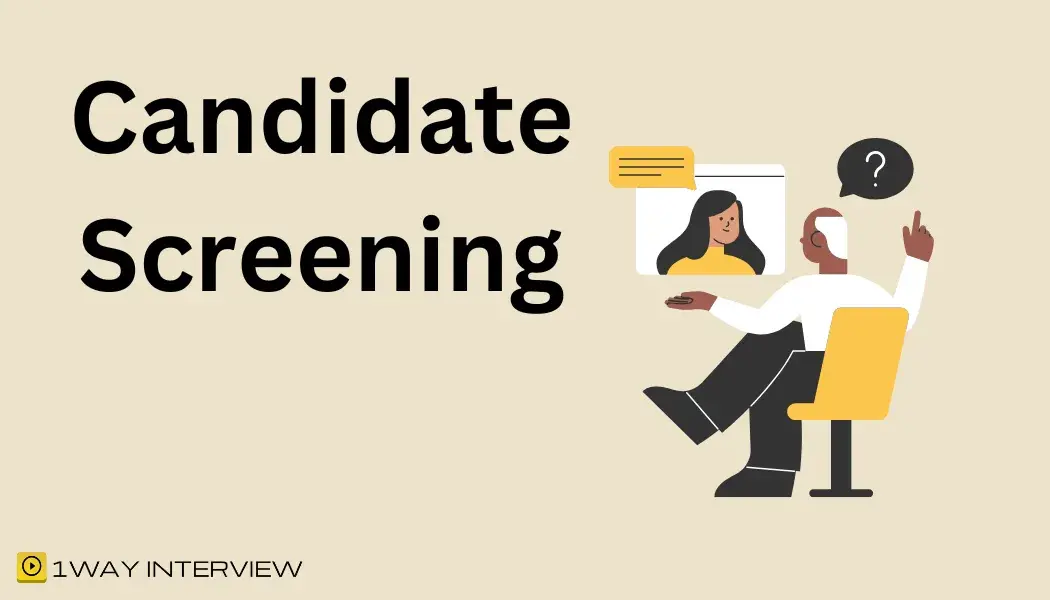Candidate screening is an essential part of the current recruitment procedures as they allow identifying suitable prospects for the vacancies of a company. For instance, it is estimated that bad hires reduce company productivity by up to 30% of an employee’s first-year salary — a clear indication that screening should be rigorous. Also, research conducted by SHRM reveals that most organizations experiencing recruitment difficulties face such challenges as
- low number of applicants (60%),
- competition from other employers (55%), and
- an increase in candidate “ghosting” (46%).
Through the correct applicant screening process, businesses can minimize the number of wrong hires, the costs associated with bad hiring decisions, and make better hiring decisions.
What Is Candidate Screening?

Candidate screening is the process of filtering the applicant pool to identify individuals who will fit an organization’s needs and culture best.
It involves evaluating applicants, scanning their CVs, and conducting interviews aimed at removing undesirable candidates from the company list.
Pre-employment screening reduces the turnover rate, improves the entire hiring process, and ensures that only the most qualified job seekers are considered.
Methods for Screening Candidates
A successful applicant screening process allows for both minimizing false-negative filtering and using the minimum possible time for the recruitment team.
Resume and Cover Letter Review
The first thing every recruiter will check for is a resume and cover letter to get an idea about the prospect’s qualifications, skills, and personality. The cover letter reveals the candidate’s level of motivation and attitude toward the screening test they are applying for. One of the first steps in screening job applicants is reviewing resumes and cover letters to evaluate:
- Matches qualifications to the required job as well as keywords that match the specific job advertised.
- Experience history for any gaps or discontinuity.
- Application letters provide a more comprehensive understanding of the candidate’s concerns as well as his or her suitability for the screening test.
There is a wide range of automation tools available for CV reviews, with the most popular options including keyword scanners and LinkedIn monitors.
Strategic Risks of using keyword-based Candidate Screening tools
The issue with using these candidate screening tools for filtering candidates out of the pool is the tremendous amount of false negatives denials that they produce. Basically, now any savvy candidate is using keyword optimization tools that help them to pass through the filter.
On the other hand, candidates who might be a great fit – especially those in high demand – do not often prioritize optimizing their CVs and may therefore be easily filtered out.
Another risk is that many candidates who care to optimise their CV use phrases and keywords that do not necessarily correspond to their actual work experience, and use them only because they were mentioned in the job description. This is very hard to identify at the screening stage.
One Way Video Interviews
During one way interviews, applicants record their response to a set of screening candidates questions formulated by the recruiters, and the response is reviewed by the former at their end. This method offers:
- Async video screening that saves time for both parties.
- General applicant evaluation for everyone. Learn more about the one way interview meaning.
Skills Assessments
Skills assessments allow an employer to check a candidate’s proficiency in a given field. Examples include:
- Coding contests/competitions specifically for developers.
- Writing exercises for content screening tests.
- Standardized behavioral cases to assess situational awareness.
Social Media Screening
Networking sites give an imposing impression of the professional and personal attributes of the candidate. Employers often review:
- Facebook profiles and LinkedIn accounts for the accomplishments.
- Comments that could imply an attitude at work or something posted on a public forum.

Reference and Background Checks
It helps to avoid cases where an employer gets the wrong information about a candidate by cross-checking references. Critical checks include:
- Verifying the prior employment screening test and duties.
- Accreditations and certifications such as educational certificates, among other courses.
- Performing criminal background checks where necessary.
Background checks also mitigate potential risks, such as hiring candidates with undisclosed criminal records or falsified credentials.
Pre-Employment Personality Tests
Employment personality tests are often used before making a job offer to a candidate. They help evaluate applicants’ traits to determine how well they might fit into the company culture. These tests allow employers to predict how someone may perform in specific roles or team settings. Well-known models include the Myers-Briggs Type Indicator and the Five Factor Model. These assessments are typically used alongside other screening tools to provide a more complete picture of a candidate’s personality.
Phone Interviews
The phone interviews are helpful when trying to determine candidates’ level of interest, their availability, and relevant qualifications. These quick interviews save time, as companies can screen applicants and save time by filtering out unsuitable job seeker in the early stages. Besides, such interviews provide a latitude for the prospects to expound on their resume information. They give information about communication skills and passion.
Thus, during phone screenings, the recruiters can ask specific questions relevant to the screening test and focus on the most promising applicants early.
AI-Powered Screening
AI-powered screening tools significantly enhance hiring efficiency, especially in scenarios with large volumes of job applications. These solutions quickly analyze resumes and candidate data, pinpointing applicants who possess specific domain expertise, relevant work experience, and proven performance metrics. As a result, employers reduce manual screening time, ensure consistency in candidate evaluation, and improve the overall quality of shortlisted applicants.
Work Portfolio Reviews
In creative and technical screening tests, portfolio reviews provide the employer with info on the performance of the candidate in the past. No matter if a person is looking for a graphic designer, software engineer, or content writer, portfolios show proof of work and willingness to do the job.
Portfolios should be evaluated on the basis of relevance to the job posting, creativity of a submission and its adherence to the firm’s norms and practices. This method can be done side by side with resume checking and will validate that the applicant has practical, hands-on experience in the industry.
Gamified Assessments
Like most games, gamified assessments are an interactive approach to assessing candidates through a transformation of conventional tests. These are designed to evaluate knowledge, aptitudes, attitudes, approaches to problems, and creativity via a gamelike format.
For instance, employers may provide virtual organizational structures with hypothetical problems or spectacular puzzles to assess challengers’ problem-solving or handling stress. This way the applicants can have a good impression of the organization since the process is fun and engaging. It also minimizes bias that would otherwise be present when evaluating outcomes using conventional unstructured scoring.

Applicant Screening Questions
Job applicant screening questions may include those about specific prior experience to determine if an applicant possesses relevant skills to do the job and certain behavioural patterns. Here are some examples:
Technical Skills Questions
- How do you stay up to date with the latest developments in this industry?
- What tools or software have you used most often in similar roles?
- Can you describe a complex project you’ve handled and how you approached it?
Behavioral Questions
- Describe a situation when you had to work with someone whose style was very different from yours.
- Tell me about a situation where you made a mistake—how did you manage it?
- Can you share an example of how you prioritized multiple tasks with tight deadlines?
- Describe an experience when you took the initiative to improve a process or workflow.
- Share an instance when you went above and beyond your job description—what motivated you?
Candidate Screening Templates
Templates play a central role in all candidate screening process as they facilitate maintaining the objectivity of the work done. Common types include:
- Interview Questionnaires: Candidate response forms that have already been developed to be used in this process.
- Evaluation Forms: Cards that could be used in ranking the applicants based on their suitability.
- Assessment Rubrics: Precise requirements for rewarding practical work assignments or compliance operations.
These templates assist the recruiters and employers in setting structures of evaluating candidates accurately
Best Practices for Screening Applicants
To optimize the screening of candidates, consider these best practices:
- Define clear job requirements: List down the competencies required on the job, the expertise that is necessary and the required personality.
- Use multiple evaluation methods: INTERVIEW + TEST + REFERENCE CHECK
- Adopt technology: Minimize use of applications and resumes to filter candidates to avoid time wastage and also filter out any biased people.
- Stay compliant: Observe and follow the provisions of labor laws and should not engage or participate in unfair hiring.
- Document evaluations: Make sure that there is a record kept bearing the facts regarding why a certain candidate was hired if needs arose.
Conclusion
Candidate screening is pivotal in identifying top talent and improving hiring outcomes. By adopting effective methods, asking targeted questions, and utilizing templates, employers can enhance their hiring strategies. 1Way Interview company will simplify and accelerate such a complicated process, adding skills assessment and video to the mix.
Are you ready to optimize your hiring? Try it today to experience effortless screening!
FAQ
Why Is Candidate Screening Important?
It allows the total attention to be paid to the qualified candidates, thus avoiding high costs in the recruitment process as well as minimizing on wrong hires.
What to Look for in a Resume When Screening Candidates?
These can include skills applicable to the job, achievements that are quantifiable and the experience that the candidate will bring to the screening test. Look for signs like gaps in employment history or general duties and responsibilities listed.
What Are the Different Approaches and Techniques for Screening Candidates?
These methods include resume comparison, record and telephone interviews, simulated work sample tests, contacting references and employment history verification, and use of social networks. Each gives a different perspective on how that candidate might perform.